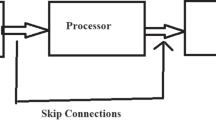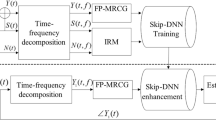Abstract
Many classic chirp signal processing algorithms may show significant performance degradation when the signal-to-noise ratio (SNR) is low. To address this problem, this paper proposes a pre-filtering method in time-domain based on deep learning. Different from traditional signal filtering methods, the proposed denoising convolutional neural network (DCNN) is trained to recover the pure signal from the noisy signal as much as possible. Following denoising, we use two classic chirp signal parameter estimation algorithms to estimate the parameters of the DCNN output. The simulation results show that, compared with no DCNN processing, the parameter estimation accuracy is significantly improved. This is mainly due to the powerful pure signal extraction ability of DCNN, which can significantly improve the SNR and the accuracy of signal parameter estimation.











Similar content being viewed by others
Data Availability
The datasets generated during and/or analyzed during the current study are available from the corresponding author on reasonable request.
References
J. Brynolfsson, M. Sandsten, Classification of one-dimensional non-stationary signals using the Wigner–Ville distribution in convolutional neural networks, in 2017 25th European Signal Processing Conference (EUSIPCO), Kos, Greece (2017), pp. 326–330
X. Chen, Q. Jiang, N. Su, B. Chen, J. Guan, LFM signal detection and estimation based on deep convolutional neural network, in 2019 Asia-Pacific Signal and Information Processing Association Annual Summit and Conference (APSIPA ASC), Lanzhou, China (2019), pp. 753–758
K. Czarnecki, M. Moszyński, A novel method of local chirp-rate estimation of LFM chirp signals in the time-frequency domain, in 2013 36th International Conference on Telecommunications and Signal Processing (TSP), Rome (2013), pp 704–708
K. Diederik, J. Ba, Adam: A Method for Stochastic Optimization. Computer Science (2014)
K. Ding, Q. Ding, R.Z. Lan, Parameters estimation of LFM signal based on fractional order cross spectrum, in Proceedings of 2011 International Conference on Electronic & Mechanical Engineering and Information Technology, Harbin (2011), pp. 654–656
Y. Ding, L. Sun, H. Zhang, B. Zheng, A multi-component LFM signal parameters estimation method using STFT and Zoom-FRFT, in 2016 8th IEEE International Conference on Communication Software and Networks (ICCSN), Beijing (2016), pp. 112–117
H. Hang, Time-frequency DOA estimation based on Radon–Wigner transform, in 2006 8th International Conference on Signal Processing, Guilin, China (2006)
S. Ioffe, C. Szegedy, Batch normalization: accelerating deep network training by reducing internal covariate shift. JMLR.org (2015)
L.A.A. Irkhis, A.K. Shaw, Compressive chirp transform for estimation of chirp parameters, in 2019 27th European Signal Processing Conference (EUSIPCO), A Coruna, Spain (2019), pp. 1–5
Y. Jiang, H. Li, M. Rangaswamy, Deep learning denoising based line spectral estimation. IEEE Signal Process. Lett. 26(99), 1573–1577 (2019)
H. Jin, W. Li, X. Wang, Y. Zhang, S. Yu, Q. Shi, Preamble detection for underwater acoustic communications based on convolutional neural networks, in 2018 OCEANS—MTS/IEEE Kobe Techno-Oceans (OTO), Kos, Greece (2018), pp. 1–6
Y. Lin, Y. Peng, X. Wang, Maximum likelihood parameter estimation of multiple chirp signals by a new Markov chain Monte Carlo approach, in Proceedings of the 2004 IEEE Radar Conference (IEEE Cat. No.04CH37509), Philadelphia, PA, USA (2004), pp. 559–562
D. Liu, S. Paris, K. Minje, Experiments on deep learning for speech denoising, in INTERSPEECH-2014 (2014), pp. 2685–2689
B. Liu, X. Tao, X. Qin, Y. Duan, J. Lu, Hyperspectral image denoising via nonnegative matrix factorization and convolutional neural networks, in 2018 IEEE International Geoscience and Remote Sensing Symposium(IGARSS 2018) (IEEE, 2018)
V.A. Narayanan, K. Prabhu, The fractional Fourier transform: theory, implementation and error analysis. Microprocess. Microsyst. 27(10), 511–521 (2003)
S. Saha, S. Kay, A noniterative maximum likelihood parameter estimator of superimposed chirp signals, in 2001 IEEE International Conference on Acoustics, Speech, and Signal Processing. Proceedings (Cat. No.01CH37221), Salt Lake City, UT, USA (2001), pp. 3109–3112
S. Saha, S.M. Kay, Maximum likelihood parameter estimation of superimposed chirps using Monte Carlo importance sampling. IEEE Trans. Signal Process. 50(2), 224–230 (2002)
W. Shan, P. Liu, L. Mu, C. Cao, G. He, Hyperspectral image denoising with dual deep CNN. IEEE Access 7, 171297–171312 (2019)
J.C. Wood, D.T. Barry, Radon transformation of time–frequency distributions for analysis of multicomponent signals. IEEE Trans. Signal Process. 42(11), 3166–3177 (1994)
K. Zhang, W. Zuo, Y. Chen, D. Meng, L. Zhang, Beyond a Gaussian denoiser: residual learning of deep CNN for image denoising. IEEE Trans. Image Process. 26(7), 3142–3155 (2016)
H. Zou, R. Lan, Y. Zhong, Z. Liu, X. Luo, EDCNN: a novel network for image denoising, 2019 IEEE International Conference on Image Processing (ICIP), Taipei, Taiwan (2019), pp. 1129–1133
Acknowledgements
This manuscript has benefited greatly from the constructive comments and helpful suggestions of the anonymous referees; the authors would like to express their deep gratitude to them.
Funding
Funding was provided by National Natural Science Foundation of China Grant 11703027.
Author information
Authors and Affiliations
Corresponding author
Ethics declarations
Conflict of interest
The authors declare that they have no conflict of interest.
Additional information
Publisher's Note
Springer Nature remains neutral with regard to jurisdictional claims in published maps and institutional affiliations.
Rights and permissions
About this article
Cite this article
Ben, G., Zheng, X., Wang, Y. et al. Chirp Signal Denoising Based on Convolution Neural Network. Circuits Syst Signal Process 40, 5468–5482 (2021). https://doi.org/10.1007/s00034-021-01727-4
Received:
Revised:
Accepted:
Published:
Issue Date:
DOI: https://doi.org/10.1007/s00034-021-01727-4




